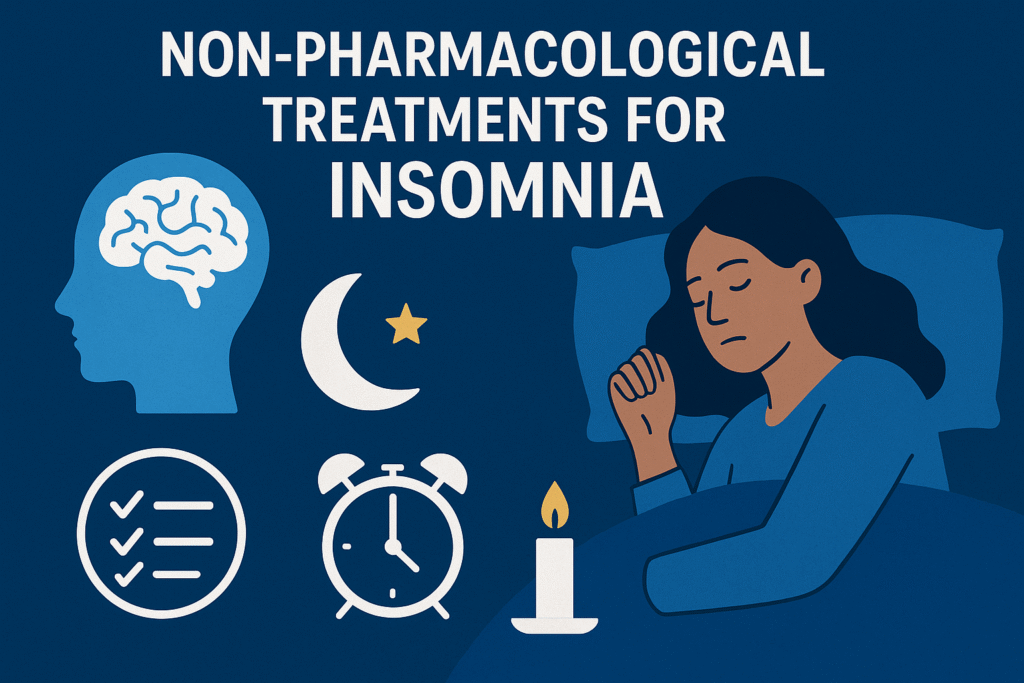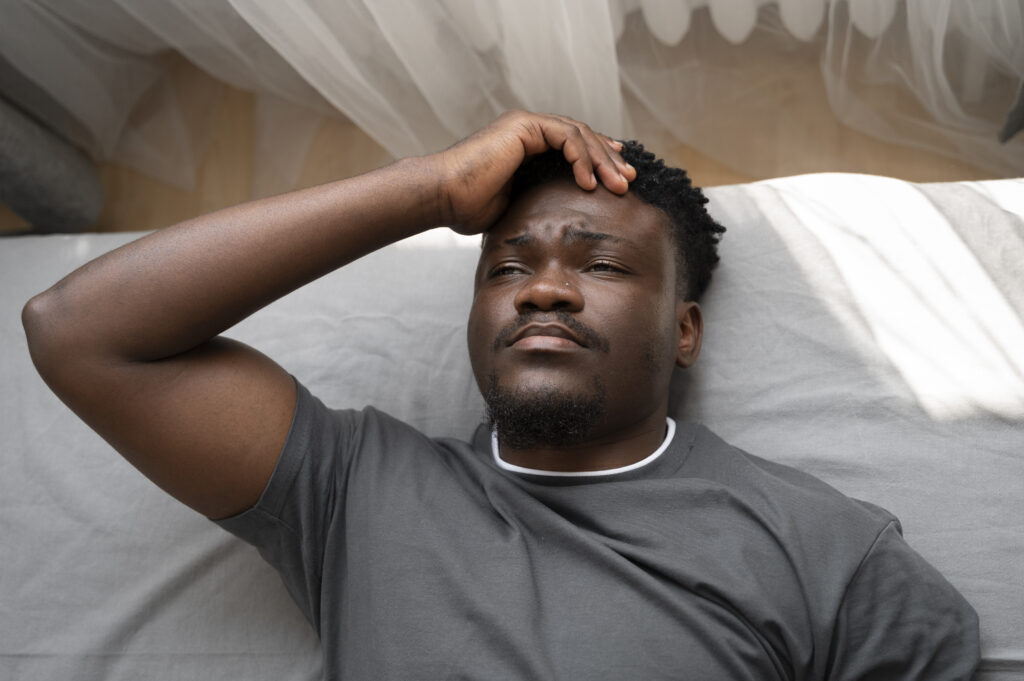
⚠️ Affiliate Disclaimer: This post may contain affiliate links, which means I may earn a small commission — at no extra cost to you — if you make a purchase through one of these links. I only recommend products or services I genuinely trust and believe can provide value. Thank you for supporting My Medical Muse!
9 Proven Non-Pharmacological Treatments for Insomnia That Actually Work
Non-Pharmacological Treatments for Insomnia: A Comprehensive Guide to Restful Sleep
Insomnia is one of the most prevalent sleep disorders worldwide, affecting millions of adults each year. It is characterized by difficulty falling asleep, staying asleep, or waking up too early, and it can significantly impact mental, emotional, and physical health. Chronic insomnia is linked to fatigue, reduced concentration, irritability, and an increased risk of serious conditions such as heart disease, diabetes, and depression.
While medications can provide temporary relief, they often carry side effects, risk of dependency, and limited long-term effectiveness. Non-pharmacological treatments, on the other hand, address the root causes of insomnia. By targeting behaviors, thought patterns, and daily routines, these approaches help individuals achieve restorative sleep naturally and sustainably.
This guide explores the most effective non-pharmacological strategies for insomnia, including cognitive behavioral therapy, lifestyle modifications, mindfulness practices, and complementary therapies. Whether you struggle with short-term sleep disruption or chronic insomnia, these evidence-based approaches offer safe, long-lasting solutions to reclaim your nights and restore your overall health.
Understanding Insomnia
Before exploring treatment options, it’s essential to understand what insomnia is and how it affects the body and mind. Insomnia is a sleep disorder characterized by difficulty falling asleep, staying asleep, or experiencing restorative sleep. While occasional sleepless nights are normal, persistent sleep difficulties can have serious consequences for physical and mental health.
Insomnia is generally classified into two main types:
Acute Insomnia:
Acute insomnia is short-term and often triggered by stress, changes in environment, or temporary health issues. It typically lasts a few days to a few weeks and usually resolves once the triggering factor is removed. Examples include difficulty sleeping before an important exam, after a stressful day, or during travel across time zones.Chronic Insomnia:
Chronic insomnia is more persistent, occurring at least three nights per week for three months or longer. Unlike acute insomnia, chronic insomnia often stems from multiple factors, including lifestyle habits, underlying medical conditions, psychological stress, or mental health disorders such as anxiety and depression. Chronic insomnia can create a cycle of worry and poor sleep habits that further disrupts sleep patterns.
Common Symptoms of Insomnia:
Insomnia manifests in various ways, often affecting both nighttime sleep and daytime functioning. Typical symptoms include:
- Difficulty falling asleep despite feeling tired
- Frequent awakenings during the night
- Waking up too early and being unable to return to sleep
- Daytime fatigue, sleepiness, or low energy
- Trouble concentrating or memory lapses
- Irritability, mood swings, or heightened stress
Understanding these patterns is crucial because effective treatment begins with identifying the type and underlying causes of insomnia. By recognizing whether insomnia is acute or chronic and noting specific symptoms, individuals and healthcare providers can develop targeted strategies to improve sleep quality and overall well-being.
The Science of Sleep
Understanding how sleep works can help you appreciate why insomnia has such a profound impact on health. Sleep is not a single, uniform state but a complex cycle composed of multiple stages, each playing a unique role in physical and mental restoration.
Sleep Stages:
- NREM Stage 1 (Light Sleep): The transition from wakefulness to sleep; muscles relax and brain waves slow.
- NREM Stage 2: Deeper light sleep where body temperature drops, heart rate slows, and sleep becomes more stable.
- NREM Stage 3 (Deep Sleep): Essential for physical restoration, tissue repair, and immune system function.
- REM Sleep (Rapid Eye Movement): Critical for memory consolidation, emotional processing, and cognitive function.
How Insomnia Disrupts Sleep:
Insomnia can reduce time spent in deep sleep and REM sleep, leading to fatigue, difficulty concentrating, mood disturbances, and weakened immune function. Even partial disruption of these stages can accumulate over time, contributing to the chronic health risks associated with poor sleep.
Importance of Restorative Sleep:
Restorative sleep affects nearly every system in the body, from cardiovascular health to brain performance. Prioritizing sleep is not just about feeling rested, it is a cornerstone of overall health and well-being.
Non-pharmacological treatments aim to target the root causes of insomnia and promote natural, restorative sleep.
1. Cognitive Behavioral Therapy for Insomnia (CBT-I)
Cognitive Behavioral Therapy for Insomnia (CBT-I) is widely regarded as the most effective first-line treatment for chronic insomnia. Unlike medications, which often mask symptoms temporarily, CBT-I addresses the underlying behavioral and psychological factors that maintain poor sleep. By changing thought patterns, daily habits, and nighttime routines, CBT-I helps individuals achieve natural, restorative sleep over the long term.
Key Components of CBT-I:
- Cognitive Restructuring
This technique identifies and challenges negative thoughts about sleep, such as “I’ll never fall asleep” or “If I don’t get eight hours, my day will be ruined.” Patients learn to replace these anxious beliefs with more realistic, calming perspectives. By reducing sleep-related worry, cognitive restructuring lowers nighttime arousal and makes falling asleep easier. - Sleep Restriction Therapy
Sleep restriction therapy helps improve sleep efficiency, the proportion of time in bed actually spent sleeping. It involves temporarily limiting the time spent in bed to match average nightly sleep, then gradually increasing it as sleep quality improves. This approach reduces frustration from lying awake and strengthens the body’s natural sleep drive. - Stimulus Control Therapy
Stimulus control aims to rebuild a strong association between the bed and sleep. Key guidelines include:
- Use the bed only for sleep and intimacy.
- Go to bed only when sleepy.
- If unable to sleep within 15-20 minutes, leave the bed and return only when drowsy.
These strategies help the brain learn that the bed is a cue for sleep, not wakefulness.
- Relaxation Techniques
Relaxation exercises reduce both mental and physical arousal, making it easier to fall asleep. Common methods include:
- Progressive Muscle Relaxation (PMR): Systematically tensing and relaxing muscle groups to release tension.
- Deep Breathing Exercises: Techniques like diaphragmatic breathing or the 4-7-8 method calm the nervous system.
- Mindfulness Meditation: Encourages non-judgmental awareness of thoughts and sensations, reducing racing thoughts at bedtime.
- Sleep Hygiene Education
Sleep hygiene focuses on creating an environment and lifestyle that support healthy sleep patterns. Patients learn to optimize factors such as:
- Bedroom lighting, noise levels, and temperature
- Limiting caffeine, nicotine, and heavy meals near bedtime
- Establishing consistent sleep and wake times
- Creating a relaxing pre-sleep routine
Effectiveness of CBT-I:
Research consistently shows that CBT-I improves sleep onset, reduces nighttime awakenings, and enhances overall sleep quality. Unlike medication, the benefits persist long-term, equipping individuals with sustainable tools to manage insomnia without reliance on drugs.
2. Sleep Hygiene Practices
Sleep hygiene encompasses the daily habits and environmental factors that support consistent, restorative sleep. While it may not completely resolve chronic insomnia on its own, good sleep hygiene forms the foundation for all non-pharmacological approaches and enhances the effectiveness of therapies like CBT-I.
Key Sleep Hygiene Strategies:
- Maintain a Consistent Sleep Schedule
Going to bed and waking up at the same time every day, including weekends, helps regulate your body’s internal clock (circadian rhythm). A stable schedule reinforces natural sleep-wake cycles, making it easier to fall asleep at night and wake up feeling refreshed. - Optimize Your Sleep Environment
Your bedroom should promote relaxation and minimize disruptions:
- Keep the room dark, quiet, and cool (ideally 60-67°F or 15-20°C).
- Invest in a comfortable mattress and supportive pillows.
- Remove electronic devices or anything that emits light or causes distractions.
- Limit Stimulants
Caffeine and nicotine are powerful stimulants that can interfere with falling asleep. Avoid consuming coffee, tea, chocolate, energy drinks, and tobacco for at least 4-6 hours before bedtime. Heavy or spicy meals close to bedtime can also disrupt sleep, so plan lighter dinners in the evening. - Limit Alcohol
While alcohol may initially make you feel drowsy, it disrupts deep sleep later in the night, leading to fragmented, less restorative rest. Minimize alcohol consumption, particularly in the hours leading up to bedtime. - Engage in Regular Exercise
Moderate daytime exercise improves sleep quality, increases total sleep time, and reduces sleep onset latency. However, avoid vigorous exercise right before bed, as it can raise heart rate and body temperature, making it harder to fall asleep. - Establish a Relaxing Bedtime Routine
Engage in calming activities that signal to your body that it’s time to wind down. Examples include reading a book, gentle stretching, meditation, or taking a warm bath. Consistent bedtime rituals help train your brain to associate these cues with sleep. - Avoid Late-Day Naps
While short daytime naps can be restorative, long or late-afternoon naps reduce sleep pressure, making it harder to fall asleep at night. If you need a nap, limit it to 20-30 minutes and take it early in the day.
Incorporating these sleep hygiene practices consistently helps create an environment and routine that supports natural, restorative sleep. When combined with behavioral therapies and mindfulness strategies, these habits can significantly improve both sleep quality and overall health.
3. Mindfulness and Meditation
Stress, anxiety, and racing thoughts are major contributors to insomnia. Mindfulness and meditation techniques help calm the mind, reduce mental arousal, and prepare the body for restful sleep. These practices teach individuals to observe thoughts without judgment and develop a sense of mental calm that carries into bedtime.
Effective Techniques for Better Sleep:
- Mindfulness Meditation: Focuses on present-moment awareness by observing thoughts, sensations, and emotions without judgment. Studies show it can reduce sleep latency (the time it takes to fall asleep) and improve overall sleep efficiency.
- Progressive Muscle Relaxation (PMR): Involves systematically tensing and relaxing each muscle group to release physical tension and signal the body that it’s time to rest.
- Guided Imagery: Encourages visualization of calming scenes or positive experiences, which can ease mental stress and reduce anxiety before bedtime.
- Breathing Exercises: Methods like the 4-7-8 technique slow the heart rate and activate the body’s relaxation response, making it easier to fall asleep naturally.
Research consistently shows that mindfulness-based interventions can improve sleep quality, especially for individuals whose insomnia is driven by stress or overactive thought patterns. Regular practice enhances relaxation and strengthens the mind-body connection, supporting long-term sleep improvements.
4. Behavioral Approaches
Behavioral interventions complement cognitive and mindfulness strategies by targeting habits and routines that interfere with sleep. By changing these behaviors, individuals can retrain their brains to associate nighttime with rest rather than wakefulness.
Key Behavioral Strategies:
- Paradoxical Intention: Instead of forcing sleep, patients are encouraged to stay awake. This counterintuitive approach reduces performance anxiety around falling asleep, making sleep come more naturally.
- Sleep Compression: Similar to sleep restriction, sleep compression gradually reduces the time spent in bed to match actual sleep duration, increasing sleep efficiency and reducing time spent awake in bed.
- Bedtime Anchoring: Establishing specific pre-sleep cues such as a relaxing ritual, dim lights, or calming music—signals the brain that it is time to wind down, strengthening the sleep association.
- Avoid Clock-Watching: Continuously checking the time at night increases anxiety and hyperarousal, making it harder to fall back asleep. Turning clocks away from view can minimize this stress.
Behavioral strategies are particularly effective when combined with cognitive techniques like CBT-I. Together, they help break the cycle of insomnia by reducing anxiety, improving sleep efficiency, and reinforcing positive sleep behaviors.
5. Light Therapy
The body’s circadian rhythm its internal biological clock is highly sensitive to light exposure. Disruptions in this rhythm can make it difficult to fall asleep, stay asleep, or wake up at the desired time. Light therapy uses controlled exposure to bright light to help reset the circadian clock and improve sleep patterns.
How Light Therapy Works:
- Morning Light: Exposure to bright light in the morning, such as sunlight or a light therapy box, can advance sleep timing. This is especially helpful for “night owls” or those who struggle to fall asleep early.
- Evening Light Avoidance: Reducing exposure to blue light from phones, computers, and TVs in the evening encourages natural melatonin production, signaling to the body that it is time to prepare for sleep.
Light therapy is particularly effective for circadian rhythm-related insomnia, such as delayed sleep phase syndrome. Consistent application can improve sleep onset, duration, and overall quality.
6.Complementary and Alternative Therapies
Several complementary approaches may enhance sleep, though the strength of evidence varies:
- Acupuncture: Research suggests it may reduce the time it takes to fall asleep and improve overall sleep quality in chronic insomnia patients.
- Aromatherapy: Scents like lavender or chamomile can promote relaxation and a sense of calm, aiding in sleep initiation.
- Yoga and Gentle Stretching: Reduces muscle tension and stress, supporting easier sleep onset and deeper rest.
- Herbal Supplements: Valerian root, chamomile, and passionflower are sometimes used as sleep aids. Evidence is mixed, and they should be used cautiously, preferably under professional guidance.
7. Lifestyle Modifications
Daily lifestyle choices have a significant impact on sleep quality. Simple, consistent adjustments can produce noticeable improvements:
- Diet: Eating sleep-promoting foods such as cherries, almonds, and magnesium- or tryptophan-rich foods can support natural sleep mechanisms.
- Regular Exercise: Moderate physical activity enhances sleep efficiency and helps regulate circadian rhythms. Avoid intense exercise immediately before bedtime.
- Stress Management: Techniques like journaling, counseling, creative hobbies, or mindfulness reduce stress, a major trigger of insomnia.
- Limiting Screen Time: Reducing exposure to electronic devices at least an hour before bed minimizes blue light interference, helping the body produce melatonin naturally.
8. Technology-Assisted Interventions
Modern technology offers new tools to support better sleep, but they work best as supplements to behavioral and cognitive strategies:
- Sleep Tracking Apps: Monitor sleep patterns, detect disruptions, and identify habits or triggers that interfere with sleep.
- CBT-I Online Programs: Digital platforms provide structured CBT-I programs, guiding users through cognitive and behavioral strategies to improve sleep.
- White Noise Machines or Apps: Help mask environmental disturbances, such as traffic or noisy neighbors, to maintain uninterrupted sleep.
Note: Technology should complement, not replace, foundational approaches like CBT-I, sleep hygiene, and relaxation techniques. Used strategically, these tools can enhance awareness, consistency, and overall sleep quality.
Common Myths About Insomnia
Many people misunderstand insomnia, which can worsen anxiety and perpetuate sleep problems. Debunking these myths is crucial for adopting effective sleep strategies.
Myth 1: “I can catch up on sleep on weekends.”
- Reality: Irregular sleep schedules confuse your circadian rhythm, making it harder to fall asleep and wake up consistently.
Myth 2: “Watching TV or scrolling on my phone helps me relax before bed.”
- Reality: The blue light emitted by screens suppresses melatonin, delaying sleep onset and reducing sleep quality.
Myth 3: “I need exactly 8 hours of sleep every night.”
- Reality: Sleep needs vary by age, genetics, and lifestyle. Quality of sleep matters as much as quantity.
Myth 4: “Taking sleep medications is the fastest way to fix insomnia.”
- Reality: Medications may provide short-term relief, but they do not address underlying causes and can lead to dependency or side effects.
Myth 5: “If I lie in bed awake, I’ll eventually fall asleep.”
- Reality: Prolonged wakefulness in bed reinforces negative sleep associations, making insomnia worse. Techniques like stimulus control and relaxation exercises are more effective.
When to Seek Professional Help
Non-pharmacological treatments are highly effective for many individuals, but some cases of insomnia require evaluation and guidance from a healthcare professional. Seek professional help if you experience:
- Persistent insomnia lasting three months or longer despite consistent self-care and behavioral interventions.
- Insomnia linked to mental health conditions, such as severe depression, anxiety, or chronic stress.
- Significant daily impairment, including excessive fatigue, difficulty functioning at work or home, or cognitive difficulties.
- Possible underlying sleep disorders, such as sleep apnea, restless leg syndrome, or circadian rhythm disorders.
A sleep specialist can provide a comprehensive assessment, identify underlying causes, and develop a personalized treatment plan. This may include behavioral therapies, lifestyle adjustments, and, if necessary, targeted medical interventions. Early intervention can prevent insomnia from becoming a chronic, self-perpetuating problem.
Conclusion
Non-pharmacological treatments for insomnia provide safe, sustainable, and effective strategies for improving sleep without the risks associated with medications. Approaches such as cognitive behavioral therapy, mindfulness and meditation, sleep hygiene, lifestyle adjustments, and complementary therapies tackle the root causes of sleep difficulties and restore natural, restorative sleep patterns.
Consistent application of these strategies not only improves sleep but also enhances mental clarity, emotional stability, and overall well-being. While it may take time to see results, the long-term benefits are substantial, empowering individuals to reclaim restful, rejuvenating nights.
Sleep is not a luxury, it is a cornerstone of health. By adopting these evidence-based strategies, anyone struggling with insomnia can regain control over their sleep and enjoy the restorative rest they deserve.
👩⚕️ Need Personalized Health Advice?
Get expert guidance tailored to your unique health concerns through MuseCare Consult. Our licensed doctors are here to help you understand your symptoms, medications, and lab results—confidentially and affordably.
👉 Book a MuseCare Consult Now

